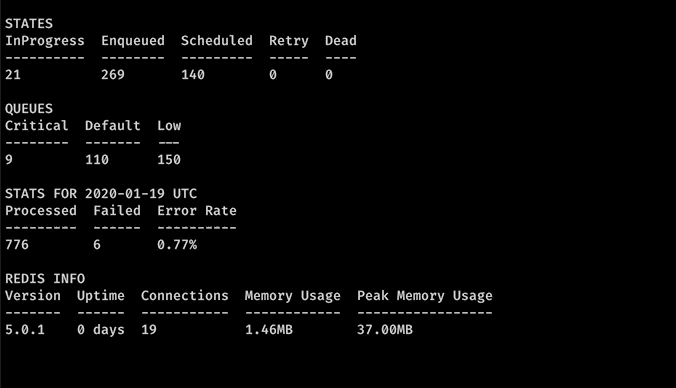Asynq
Simple and efficent asynchronous task processing library in Go.
Important Note: Current major version is zero (v0.x.x) to accomodate rapid development and fast iteration while getting early feedback from users. The public API could change without a major version update before the release of verson 1.0.0.
Table of Contents
Overview
Asynq provides a simple interface to asynchronous task processing.
It also ships with a tool to monitor the queues and take manual actions if needed.
Asynq provides:
- Clear separation of task producer and consumer
- Ability to schedule task processing in the future
- Automatic retry of failed tasks with exponential backoff
- Automatic failover using Redis sentinels
- Ability to configure max retry count per task
- Ability to configure max number of worker goroutines to process tasks
- Support for priority queues
- Unix signal handling to gracefully shutdown background processing
- CLI tool to query and mutate queues state for mointoring and administrative purposes
Requirements
| Dependency | Version |
|---|---|
| Redis | v2.8+ |
| Go | v1.12+ |
Installation
go get -u github.com/hibiken/asynq
Getting Started
- Import
asynqin your file.
import "github.com/hibiken/asynq"
- Asynq uses redis as a message broker.
Use one of
RedisConnOpttypes to specify how to connect to Redis.
var redis = &asynq.RedisClientOpt{
Addr: "localhost:6379",
// Omit if no password is required
Password: "mypassword",
// Use a dedicated db number for asynq.
// By default, Redis offers 16 databases (0..15)
DB: 0,
}
- Create a
Clientinstance to create and schedule tasks.
func main() {
client := asynq.NewClient(redis)
// Create a task with typename and payload.
t1 := asynq.NewTask(
"send_welcome_email",
map[string]interface{}{"user_id": 42})
t2 := asynq.NewTask(
"send_reminder_email",
map[string]interface{}{"user_id": 42})
// Process the task immediately.
err := client.Schedule(t1, time.Now())
// Process the task 24 hours later.
err = client.Schedule(t2, time.Now().Add(24 * time.Hour))
// Specify the max number of retry (default: 25)
err = client.Schedule(t1, time.Now(), asynq.MaxRetry(1))
}
- Create a
Backgroundinstance to process tasks.
func main() {
bg := asynq.NewBackground(redis, &asynq.Config{
Concurrency: 10,
})
// Blocks until signal TERM or INT is received.
// For graceful shutdown, send signal TSTP to stop processing more tasks
// before sending TERM or INT signal to terminate the process.
bg.Run(handler)
}
Note that Client and Background are intended to be used in separate executable binaries.
The argument to (*asynq.Background).Run is an interface asynq.Handler which has one method ProcessTask.
// ProcessTask should return nil if the processing of a task
// is successful.
//
// If ProcessTask return a non-nil error or panics, the task
// will be retried.
type Handler interface {
ProcessTask(*Task) error
}
The simplest way to implement a handler is to define a function with the same signature and use asynq.HandlerFunc adapter type when passing it to Run.
func handler(t *asynq.Task) error {
switch t.Type {
case "send_welcome_email":
id, err := t.Payload.GetInt("user_id")
if err != nil {
return err
}
fmt.Printf("Send Welcome Email to %d\n", id)
// ... handle other types ...
default:
return fmt.Errorf("unexpected task type: %s", t.Type)
}
return nil
}
func main() {
bg := asynq.NewBackground(redis, &asynq.Config{
Concurrency: 10,
})
// Use asynq.HandlerFunc adapter for a handler function
bg.Run(asynq.HandlerFunc(handler))
}
Monitoring CLI
Asynq ships with a CLI tool to inspect the state of queues and tasks.
To install the CLI, run the following command:
go get github.com/hibiken/asynq/tools/asynqmon
For details on how to use the tool, see the README for the asynqmon CLI.
Acknowledgements
- Sidekiq : Many of the design ideas are taken from sidekiq and its Web UI
- Cobra : Asynqmon CLI is built with cobra
License
Asynq is released under the MIT license. See LICENSE.

